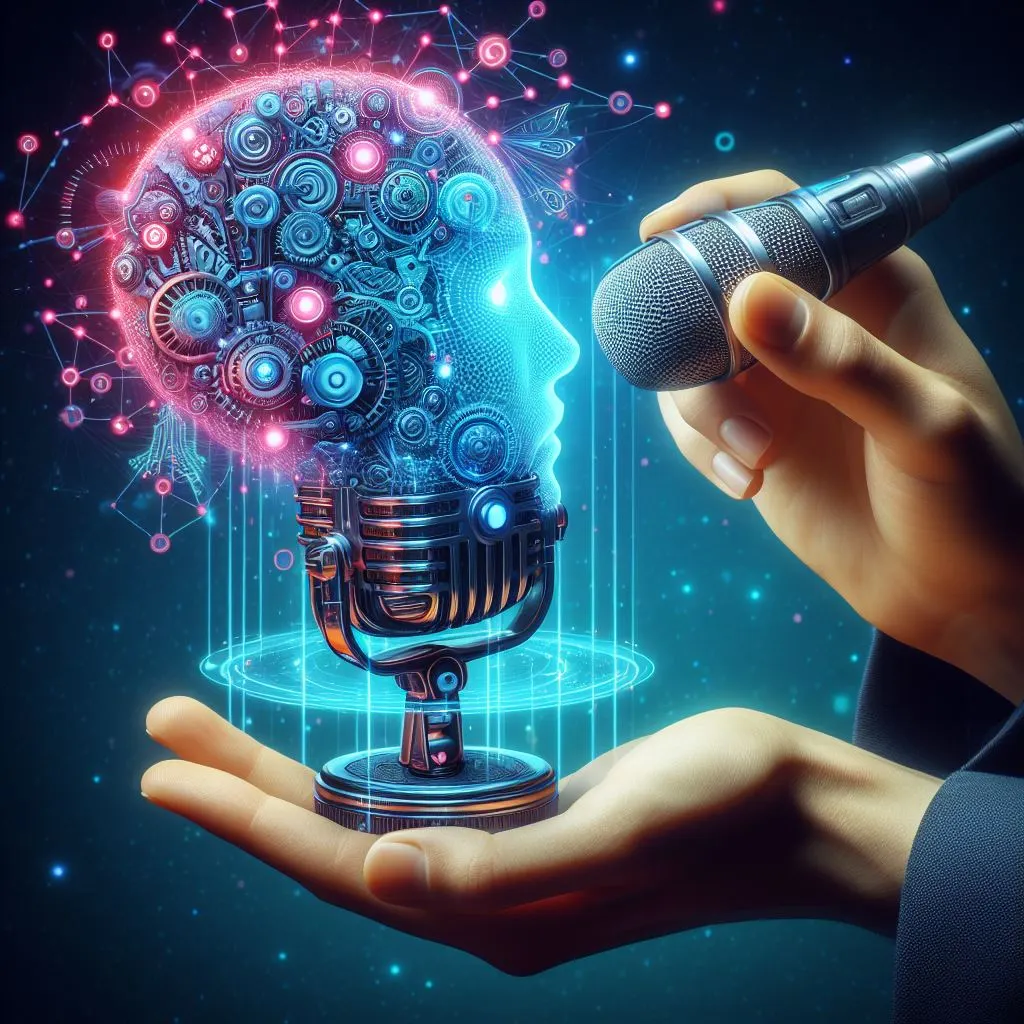In the rapidly evolving landscape of artificial intelligence, the launch of OpenAI Voice Engine has sparked a revolution in how we interact with digital content and services, ushering in an era of high-quality synthetic voice interactions.
This groundbreaking technology is poised to reshape the realms of media, education, and even healthcare, empowering individuals and organizations to harness the power of natural, human-like voice interactions. Let’s discuss in detail.
Clarity and Coherence: The Hallmarks of OpenAI Voice Engine
At the heart of OpenAI’s Voice Engine lies a relentless pursuit of clarity and coherence, two essential elements that have often eluded traditional voice AI systems, making it a standout AI model in the realm of text-to-speech technology. The advanced deep learning algorithms powering this technology meticulously analyze reference sounds, enabling the generation of new audio that authentically replicates the nuances of human speech and includes a watermark to safeguard against misuse.
Why Clarity and Coherence Matter
Clarity and coherence, the foundation of effective communication, are achievable through advanced generative AI technology including chatGPT, which has been greatly improved since late 2022. Without them, the intended message becomes a garbled mess, losing its impact and leaving the listener frustrated, underlining the importance of deploying advanced AI with safeguards against misuse. For AI-powered voice systems, achieving clarity means delivering crisp, understandable audio that does not strain the listener’s ears, often through the use of high-quality audio samples. Coherence, on the other hand, refers to the logical sequencing and context-appropriate responses by the AI model that make the interaction feel natural and intuitive.
Redefining the Boundaries of Natural-Sounding Speech

OpenAI Voice Engine, featuring chatGPT integration, surpasses its counterparts by not only achieving clarity and coherence but also excelling in tone, naturalness, and the creation of AI-generated synthetic voices that closely match the original speaker. This is possible thanks to the deep learning algorithms that analyze the reference sound in granular detail, capturing the subtle inflections, rhythms, and emotional cues that give human speech its distinctive character. The result is an audio output that can engage in conversation, read aloud, or translate content with a naturalness that is truly astonishing, thanks to the advanced text-to-speech capabilities of the AI model.
Transforming Media and Education

The disruptive potential of OpenAI Voice Engine, especially with chatGPT integration, is most evident in the realms of media and education, where it is poised to revolutionize the way content is consumed and learning is facilitated, with a focus on the ethical deployment to prevent misuse.
Enhancing Accessibility and Inclusivity in Education
Consider the story of Elise, a young student who struggled with dyslexia and found reading her science textbook a daunting task until she utilized the text-to-speech feature of the AI model for assistance. The introduction of OpenAI Voice Engine transformed her learning experience, as the clear, coherent, and natural-sounding voice read the text aloud, enabling her to comprehend the material without the added strain of deciphering the written word.
This anecdote encapsulates the profound impact of OpenAI Voice Engine, a generative AI with chatGPT integration, in the education sector, highlighting its potential to mimic the original speaker with high fidelity. By empowering non-readers and young learners to engage with content through a more accessible and personalized medium, this technology has the potential to remove barriers and democratize learning, making it accessible and enjoyable for all.
Revolutionizing Video Translation and Expansion
The open AI Voice Engine’s capabilities, powered by generative AI, extend beyond the realm of education, with companies like HeyGen leveraging it to revolutionize the video translation and localization industry. Prior to the integration of this AI technology, translating videos was a time-consuming and expensive process, often resulting in noticeable discrepancies in voice quality and accuracy.
With OpenAI Voice Engine, HeyGen can now produce high-quality dubbed versions of videos quickly and cost-effectively, with natural-sounding, AI-generated translations that cater to a global audience. The seamless language translation capabilities of the Voice Engine have the power to make content more accessible and inclusive, breaking down linguistic barriers and expanding the reach of media organizations.
Enhancing Service Delivery in Remote Areas
Innovation and adaptability are the keys to solving humanitarian and development challenges, and Dimagi, a mobile app technology company, is demonstrating this by leveraging OpenAI Voice Engine to enhance its service delivery in remote areas.
Dimagi’s platform provides basic services and information in the user’s native language, particularly in regions with limited internet connectivity or low literacy levels, including the deployment of audio samples for clearer communication. However, reaching out to diverse local populations and catering to their unique linguistic needs with synthetic voice technology can be a daunting task.
By integrating OpenAI’s Voice Engine, Dimagi can now provide interactive feedback to users based on their specific needs and vernacular language, tackling language barriers and improving communication through natural language processing. This transformation allows Dimagi’s platform to become a personalized tool that uniquely caters to each user, ensuring accessibility, inclusivity, and personalization in areas that have traditionally lacked such resources.
Unlocking the Potential of Voice-Driven Interactions
The integration of OpenAI’s Voice Engine, including chatGPT functionalities, into various industries and applications marks the beginning of a transformative journey with a focus on preventing misuse and ensuring accurate representation of the original speaker. As this technology, including chatGPT, continues to evolve and be adopted by more organizations since late 2022, the possibilities for profound change become limitless, especially with careful consideration of ethical deployment practices.
Empowering Patients and Individuals with Speech Disorders
One of the most profound applications of OpenAI’s Voice Engine lies in its ability to help individuals with speech disorders regain their voice and the ability to communicate effectively using AI-generated synthetic voice technology. For those who have lost the ability to speak due to medical conditions or accidents, the Voice Engine can recreate their unique voice, allowing them to express themselves with confidence and connect with the world around them.
Revolutionizing Remote Service Delivery
Beyond the education and media sectors, the Voice Engine’s impact on remote service delivery holds immense potential, including the ability to generate 15-second audio samples for quick and effective communication. In areas with limited access to resources and infrastructure, the ability to provide personalized, interactive feedback in the user’s native language through synthetic voice, including the deployment of chatGPT for seamless interaction, can be transformative. By overcoming language barriers and delivering information tailored to local needs, organizations can enhance the reach and effectiveness of their services, empowering underserved communities and improving lives.
Fostering Inclusive and Accessible Experiences
At the heart of OpenAI’s Voice Engine, with its deployment aimed at inclusivity and accessibility, lies a commitment that extends to preventing misuse through authentication measures. By making digital content and services more accessible through natural-sounding voice interactions, this technology has the power to break down barriers and ensure that everyone, regardless of their reading ability, language proficiency, or physical limitations, can engage with and benefit from the wealth of information and resources available in the digital age.
The Future of Voice-Driven Interactions

As OpenAI’s Voice Engine, a prime example of generative AI, continues to evolve and be integrated into a wide range of applications, the future of voice-driven interactions is poised to become increasingly dynamic and personalized. With the ability to understand and respond to natural language, as well as the capacity to replicate the unique characteristics of an individual’s voice, this technology is set to redefine the way we interact with digital systems and consume content.
Toward a More Inclusive and Accessible Digital Landscape
The impact of OpenAI’s Voice Engine extends far beyond the immediate benefits it brings to individual users and organizations. By democratizing access to information and services through natural, voice-driven interactions, this technology has the potential to create a more inclusive and accessible digital landscape, empowering marginalized communities and individuals with disabilities to fully participate in the digital age.
Endless Possibilities for Innovation and Creativity
As the capabilities of OpenAI’s Voice Engine, a generative AI model with chatGPT integration, continue to expand, the opportunities for innovation and creativity, alongside measures to prevent misuse and ensure authentication, will only continue to grow. From personalized virtual assistants to immersive audio experiences, the integration of this technology into various applications and industries will unlock new frontiers of human-machine interaction, redefining the way we consume, create, and engage with digital content.
Conclusion
The launch of OpenAI’s Voice Engine marks a pivotal moment in the evolution of artificial intelligence, heralding a new era of natural, human-like voice interactions that are poised to transform industries, empower individuals, and reshape the digital landscape as we know it.
By prioritizing clarity, coherence, and naturalism, this groundbreaking technology is not only enhancing accessibility and inclusivity but also opening up new avenues for creativity, innovation, and personalized experiences. As we continue to explore the boundless potential of OpenAI’s Voice Engine, the future of voice-driven interactions grows ever brighter, promising a more connected, empowered, and accessible digital world for all.


